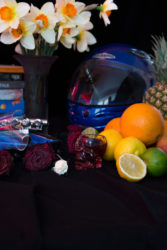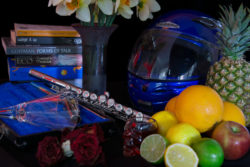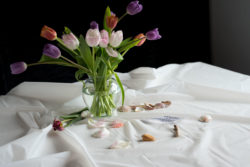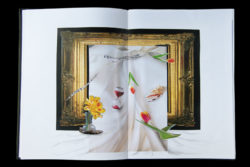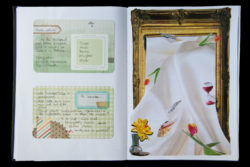‘Plastic Vanitas’ was very thought provoking. Having done previous assignments on fertility (assignment two), and my life (assignment three) it seemed like a natural next step to be considering death in my final assignment.
- Vanitas Sketch 1
- Vanitas Sketch 2
I started by creating some personal Vanitas still lives, using contemporary connotations to recreate the original style. These never became more than quick ‘sketches’ because I knew very quickly this approach was not distinctive enough. I also wanted something that looked and felt more contemporary while still using the signification of the original genre. One of the issues for me was that that the first sketches felt too cluttered so the next step was to strip everything back and using fewer referents see if I could achieve a similar signification.
- Vanitas Sketch 3
- Vanitas Sketch 4
I worked with Tulips because of their links to the Dutch Vanitas tradition (1600 -1800) and also because they could show the signs of decay as the petals fall. The Shell and bone, also elements of life and death, were placed sparingly on a crumpled white cloth a connotation of the peaks and troughs of life. This felt more along the lines of what I was trying to achieve and while I was happier with these results it still felt as though I hadn’t pushed it far enough.
In looking again at some of the original Vanitas paintings I started to think more about the frame, and how in some of the earlier paintings the elements deliberately flow forward, off the table and to the edge of the frame. Framing in both physical and metaphorical terms became the key to the next transition. The ‘frame’ became important in terms of it being a mechanism for containing the image; referring to different frames of reference; considering how we frame our lives (from birth to death) and so on. I had recently done a Photoshop exercise on creating the illusion of breaking through the image plane and decided this was the next step.
I wanted to see if I could create an image that made direct reference to challenging the boundary of the frame, therein representing the passage of time from birth to death and whatever lies beyond. In this I was also drawing on Schaverien’s (1999) psychoanalytic notion of the photographic frame creating a safe container for our anxieties, I wanted to break that safety and see what happened when the elements flowed out.
- Collage 1
- Collage 2
Before even attempting it in Photoshop I then made some physical collages using some of the elements in my sketchbook. This was particularly helpful in deciding whether they should be portrait or landscape. It also reinforced the need for the black background rather than white. I showed my sketchbook and first digital attempts to the Thames Valley Photography group and got some very helpful feedback:
- Consider if I was moving too far from the original Vanitas inspiration
- Perhaps make it more personal – what are my vanities?
- Think about drawing out the feminist issues further
- Consider making a physical collage of the photographs rather than doing it in Photoshop
This led me to thinking about producing the series of three rather than a single image. The themes arose from our group discussion and I then worked on them in my sketchbook, creating a list of possible symbols under each theme. The idea of considering individual, group and global mortality really appealed to me and while I initially waivered because of the amount of work involved for each image I decided I wanted to give it a try. The props were a mix of those I had around my home and a few that I purchase specially, including the cut flowers. I found I had chosen to do this right at the end of the Tulip season so could not access the more exotic varieties I had wanted and had to work quickly with those I did manage to find! All the props were then shot individually in natural light on a table top infinity background.
While continuing to be still lives I have tried to introduce a sense of movement, a flow through time. I wasn’t sure if I could achieve it with my Photoshop skills but I have come pretty close to what I was hoping to achieve. I may still move on to create further physical collages. Looking back it feels like the development process has a natural flow to it and the combination of research, talking to other students and experimenting feels like it paid off.
Acknowledgements:
- Mariele Neudecker for her permission to feature her images in my learning log
- The women who broke new ground – Rachel Ruysch, Clara Peeters, Giovanna Garzoni and Fede Galizia
- The Thames Valley Group and FB OCA Photography Level 1 Group
References and citations
Schaverien, J. (1999). The Revealing Image: Analytical Art Psychotherapy in Theory and in Practice. London: Routledge.
Wynne, D. (2016). Women and personal property in the Victorian novel. London: Routledge.




